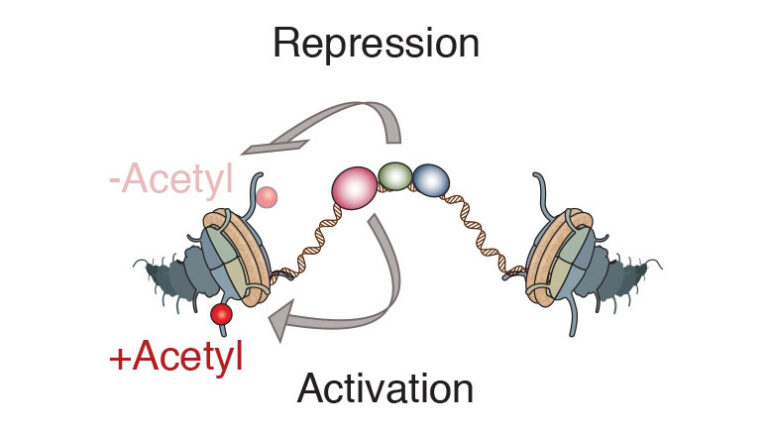KANSAS CITY, MO— The complex process regulating gene expression is often compared to following a recipe. Miss a genetic ingredient, or add it in the wrong order, and you could have a disaster on your hands.
New research from Stowers Institute for Medical Research suggests the process may be more like a battle between two opposing genetic forces rather than a step-wise assembly of ingredients.
In their report, published online in Genome Research, Stowers researchers examined regions of fruit fly DNA, called enhancers, which increase the likelihood of gene expression. Gene expression is the process of turning genes on or off, and is crucial for creating specific cells in the body such as nerve cells or cells that make up skin and bone.
But a duel comes first. Stowers Associate Investigator Julia Zeitlinger, Ph.D., and Postdoctoral Research Associate Nina Koenecke, Ph.D., discovered that DNA enhancers engage in an ongoing contest between activation and repression, which results in a different epigenetic state of the histone proteins around which DNA is wrapped. Activation sparks the addition of acetyl groups to histones, which in turn loosen their grip on DNA enhancers, allowing them to be switched on. Repression, on the other hand, removes this acetylation mark and prevents the switch from ever being flipped.
“Through this balance between forces you can shift an enhancer more easily from inactivity to activity,” Zeitlinger says.
Enhancer activation and repression are known to occur both in the fruit fly Drosophila melanogaster and in mammals. But repression is much less studied in mammals.
The finding therefore clarifies the often misunderstood role of repression in DNA enhancers, and underscores its importance as an action, and not just an inaction. Typically, activation gets the most credit for its role in gene expression. For example, enhancers that are epigenetically modified but still inactive have been thought to be “poised” for future action. However, this new evidence suggests that “poised” enhancers – rather than lacking a key ingredient for activation – may be repressed.
“When there is an opposition between the two enzymes responsible for acetylation state, it creates an ultra-sensitivity under some conditions,” Zeitlinger says. “With just a little more activation, this can create a very dramatic switch in the enhancer’s activity. This mechanism could allow a gene being turned on in some cells, while turned off in other cells of the body.”
In this study, which focused on enhancers of genes important for specifying the fruit fly body plan, Zeitlinger and her colleagues drew on knowledge from diverse sources – developmental genetics and its mechanistic analyses of DNA enhancers, mechanistic studies on histone modifications, and insights from global genomics analyses using next-generation sequencing – to develop their unifying model of how DNA enhancers work. They used ChIP-seq analysis to generate high-resolution maps of DNA enhancers under different conditions. Zeitlinger’s long-term goal is to map and understand DNA enhancers more extensively. There are hundreds of thousands of enhancers in the human genome.
Such insight could provide understanding into diseases and developmental disorders caused by DNA enhancer mutations, and give us a glimpse into the genetic forces that have contributed to human evolution.
Other Stowers contributors include Jeff Johnston, Qiye He, Ph.D., and Samuel Meier.
The work was funded by the Stowers Institute for Medical Research and a New Innovator Award from the National Institutes of Health (NIH). The content is solely the responsibility of the authors and does not necessarily represent the official views of the NIH.
Lay Summary of Findings
Gene expression is the process of turning genes on or off, and it’s essential for creating specific cells in the body. Stowers researchers examined regions of fruit fly DNA called enhancers. These enhancers increase the likelihood of gene expression. It turns out DNA enhancers are locked in an ongoing battle between activation and repression. Activation sparks DNA enhancers into action — switching them on. Repression prevents the switch from ever being flipped. Stowers Associate Investigator Julia Zeitlinger, Ph.D., and colleagues found that a crucial balance between the two actions is maintained at the level of histone modifications, around which DNA enhancers are wrapped. Such insight could provide understanding into diseases and developmental disorders caused by DNA enhancer mutations, and give us a glimpse into the genetic forces that have contributed to human evolution. The report has been published online in Genome Research.
About the Stowers Institute for Medical Research
The Stowers Institute for Medical Research is a non-profit, basic biomedical research organization dedicated to improving human health by studying the fundamental processes of life. Jim Stowers, founder of American Century Investments, and his wife, Virginia, opened the Institute in 2000. Currently, the Institute is home to about 500 researchers and support personnel, over 20 independent research programs, and more than a dozen technology development and core facilities. Learn more about the Institute at www.stowers.org and about its graduate program at www.stowers.org/gradschool.




